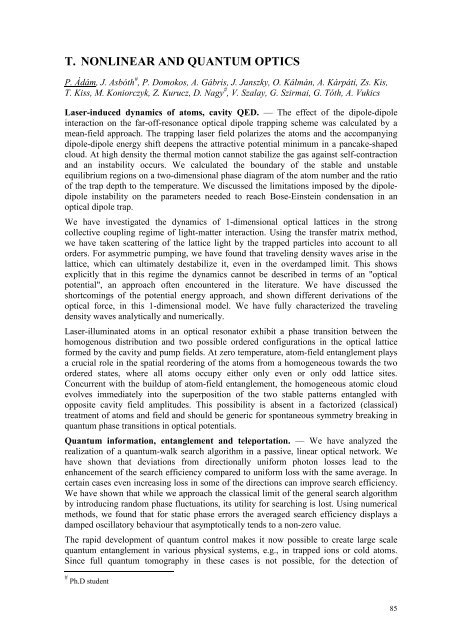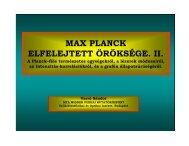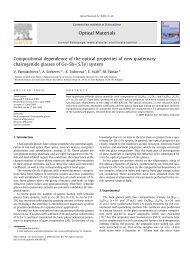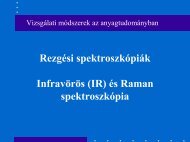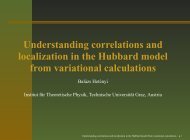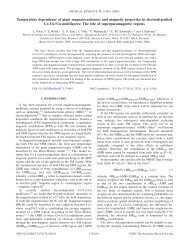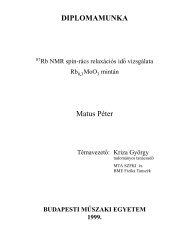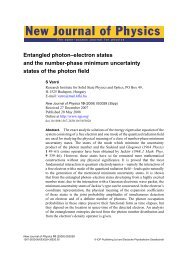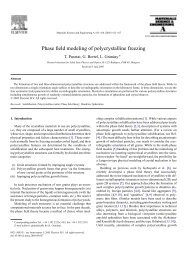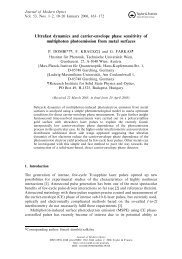ANNUAL REPORT - MTA SzFKI
ANNUAL REPORT - MTA SzFKI
ANNUAL REPORT - MTA SzFKI
Create successful ePaper yourself
Turn your PDF publications into a flip-book with our unique Google optimized e-Paper software.
T. NONLINEAR AND QUANTUM OPTICS<br />
P. Ádám, J. Asbóth # , P. Domokos, A. Gábris, J. Janszky, O. Kálmán, A. Kárpáti, Zs. Kis,<br />
T. Kiss, M. Koniorczyk, Z. Kurucz, D. Nagy # , V. Szalay, G. Szirmai, G. Tóth, A. Vukics<br />
Laser-induced dynamics of atoms, cavity QED. — The effect of the dipole-dipole<br />
interaction on the far-off-resonance optical dipole trapping scheme was calculated by a<br />
mean-field approach. The trapping laser field polarizes the atoms and the accompanying<br />
dipole-dipole energy shift deepens the attractive potential minimum in a pancake-shaped<br />
cloud. At high density the thermal motion cannot stabilize the gas against self-contraction<br />
and an instability occurs. We calculated the boundary of the stable and unstable<br />
equilibrium regions on a two-dimensional phase diagram of the atom number and the ratio<br />
of the trap depth to the temperature. We discussed the limitations imposed by the dipoledipole<br />
instability on the parameters needed to reach Bose-Einstein condensation in an<br />
optical dipole trap.<br />
We have investigated the dynamics of 1-dimensional optical lattices in the strong<br />
collective coupling regime of light-matter interaction. Using the transfer matrix method,<br />
we have taken scattering of the lattice light by the trapped particles into account to all<br />
orders. For asymmetric pumping, we have found that traveling density waves arise in the<br />
lattice, which can ultimately destabilize it, even in the overdamped limit. This shows<br />
explicitly that in this regime the dynamics cannot be described in terms of an "optical<br />
potential", an approach often encountered in the literature. We have discussed the<br />
shortcomings of the potential energy approach, and shown different derivations of the<br />
optical force, in this 1-dimensional model. We have fully characterized the traveling<br />
density waves analytically and numerically.<br />
Laser-illuminated atoms in an optical resonator exhibit a phase transition between the<br />
homogenous distribution and two possible ordered configurations in the optical lattice<br />
formed by the cavity and pump fields. At zero temperature, atom-field entanglement plays<br />
a crucial role in the spatial reordering of the atoms from a homogeneous towards the two<br />
ordered states, where all atoms occupy either only even or only odd lattice sites.<br />
Concurrent with the buildup of atom-field entanglement, the homogeneous atomic cloud<br />
evolves immediately into the superposition of the two stable patterns entangled with<br />
opposite cavity field amplitudes. This possibility is absent in a factorized (classical)<br />
treatment of atoms and field and should be generic for spontaneous symmetry breaking in<br />
quantum phase transitions in optical potentials.<br />
Quantum information, entanglement and teleportation. — We have analyzed the<br />
realization of a quantum-walk search algorithm in a passive, linear optical network. We<br />
have shown that deviations from directionally uniform photon losses lead to the<br />
enhancement of the search efficiency compared to uniform loss with the same average. In<br />
certain cases even increasing loss in some of the directions can improve search efficiency.<br />
We have shown that while we approach the classical limit of the general search algorithm<br />
by introducing random phase fluctuations, its utility for searching is lost. Using numerical<br />
methods, we found that for static phase errors the averaged search efficiency displays a<br />
damped oscillatory behaviour that asymptotically tends to a non-zero value.<br />
The rapid development of quantum control makes it now possible to create large scale<br />
quantum entanglement in various physical systems, e.g., in trapped ions or cold atoms.<br />
Since full quantum tomography in these cases is not possible, for the detection of<br />
# Ph.D student<br />
85


